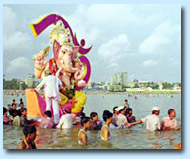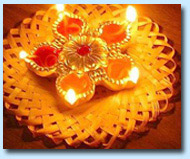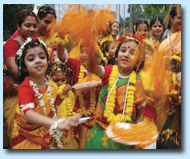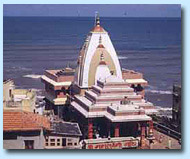|
 |
|
Explore Goa |
|
|
|
Goa Hotels |
|
|
|
Goa Tour
Packages |
|
|
|
|
 |
|
|
|
|
|
|
Hindu
Festivals in Goa |
|
In Goa, Hindus form the
majority population, which makes it obvious that the Hindu
festivals are celebrated with much joy and fervor in Goa.
The Hindu community in Goa primarily celebrates Ganesha
Chaturthi, Diwali, Dusshera, Holi, Rakshabandhan (Rakhi),
Rama Navmi and Krishna Janmashtami festivals.
Ganesha Chaturthi
Unquestionably, the most illustrious festival of Goa,
Ganesha Chaturthi is celebrated around the months of August
or September. Most Goans return to their native place of
birth or their ancestral houses to join the entire family in
the celebration of the birthday of the Elephant God, Ganesha. |
 |
|
It is
celebrated with much enthusiasm also because of its
proximity to the state of Maharashtra, where Ganesha
Chaturthi is unarguably the most important festival of the
year.
|
|
Diwali
Diwali is celebrated all over India and is also known as the
"festival of lights". Its roots can be traced back to the
era, when Lord Ram destroyed the Demon King Ravana. After
fourteen years of exile and victory over Ravana, Lord Rama
was hailed in his birthplace Ayodhya with a celebration of
crackers and lights. In Goa, Diwali is celebrated by one and
all with the same keenness and joy as all over India. All
over Goa, giant effigies of Narakasur (as Ravana is
popularly known there), dressed in colorful paper outfits
and weaponry are put up in the days foregoing Diwali. Then,
they are burnt just before sunrise. |
 |
|
Dusshera
The festival of Dusshera is celebrated just before Diwali in
Northern India. These two festivals are celebrated as one in
Goa. Huge effigies of Ravana, the demon king are burnt all
over the city at night. It marks the victory of good over
evil and denotes the fact that evil can never get away with
its misdeeds and in the end, goodwill shall be victorious.
|
|
Holi
Holi or the "festival of colors" is a very joyous occasion
and is celebrated with fun and happiness all over the
country and Goa is no exception to it. In this festival
people, smear each other with colorful powder and drench
each other in colorful water. Children run here and there
and apply color on their friends and loved ones and play in
water. The festival of Holi comes around the months of March
and April. The date is not fixed as it is based on the Hindu
calendar.
Rakshabandhan /Rakhi |
 |
|
Rakshabandhan, or popularly known as Rakhi, is celebrated
all over India with much warmth and devotion. It is a
festival in which girls tie colorful, sacred threads around
the wrists of their brothers, who in turn promise to protect
their sisters from any sort of harmful influences
whatsoever. The brothers then give their sisters a gift as a
token of their promise and love. This festival is celebrated
usually in the month of August.
Ram Navmi
Ram Navmi or the birth anniversary of Lord Rama is
celebrated on the ninth day of the expanding moon in the
months of March - April. Lord Rama is considered the seventh
incarnation of Lord Vishnu. Ram Navmi is festival which
starts from the beginning of the Hindu New Year and goes on
for as long as nine days. The temples in Goa are decorated
and the images of Lord Rama are adorned with flowers on the
occasion of Ram Navmi. Fairs are planned in a number of
places around Goa. Lord Rama's birthday is celebrated with
great pleasure and is believed to bring serenity and
happiness to the people. The biggest celebration takes place
in Southern Goa, where thousands of followers get together
to take part in the festivities.
|
|
Krishna
Janmashtami
Popularly called as Janmashtami, this festival marks the
birthday of one the most lovable gods of the Hindu folklore,
Lord Krishna. It is believed that Lord Krishna was an
incarnation of Lord Vishnu who came in the corporeal world
to destroy evil. This festival is celebrated in the months
of August - September according to the Hindu calendar.
Janmashtami is celebrated with people paying a visit to
local Krishna temples, which are particularly adorned and
lit for the occasion. A major highlight of the day is
"dahi-handi" in which young boys form a human pyramid and
try to reach a pot of curd, which is tied high up. It is
believed that Lord Krishna used to steal curd and butter
from neighboring houses by forming human pyramids with his
friends. |
 |
| Just before midnight, devotees visit temples and
perform a special "aarti" to mark the birth of lord Krishna
as he was born at midnight. |
| |
|
|
|
| |
|
|
|
|
|

